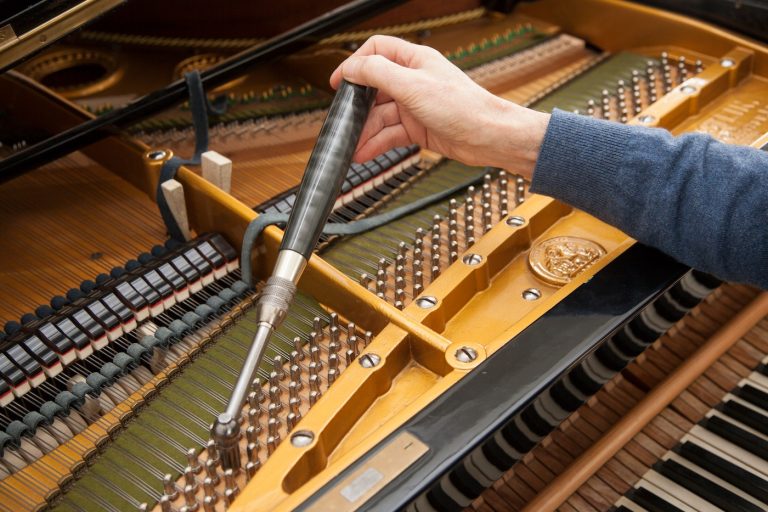Quality Care for Your Piano
Make sure your piano always looks and sounds its best with top-of-the-line piano services from Dwight Haupt’s Piano Service. Call 402-438-2393 or 402-730-9462 for an emergency or same-day service availability.
Action Regulation
Regulation is the adjustment of the mechanical aspects of the pianos to compensate for the effects of wear, the compacting and settling of cloth, felt, and buckskin, as well as dimensional changes in wood and wool parts due to changes in humidity.
Pitch Raising
Your piano is designed to sound its best when tuned to A-440 (A above middle C vibrates at 440 cycles per second), the international pitch standard. At this pitch, power and tonal range are optimum, and your piano will match the pitch of other instruments.
When your piano varies from A-440, pitch adjustment is required to bring it back to standard. By always maintaining your piano at standard pitch, you create long-term tuning stability because the strings and structure stay in equilibrium. You also ensure proper ear training because you always hear your music in the correct key.
Humidity Control
Your piano is made primarily of wood, a versatile and beautiful material ideal for piano construction. However, being made of wood, your piano is greatly affected by humidity.
Seasonal and even daily changes in humidity cause wood parts to swell and shrink that affects tuning stability and touch. Extreme swings in humidity can eventually cause wood to crack and glue joints to fail.
Other materials in your piano also are affected by changes in moisture content in the air. The many felt and leather parts in your piano’s action can change dimension, affecting regulation and friction or stiffness of the touch. Very high humidity can even create condensation on metal parts such as strings, tuning pins and hardware, eventually causing them to rust.
While not eliminating the need for regular piano maintenance, humidity control will allow more stable tuning by reducing the radical pitch changes your piano may experience through the seasons.
When your piano stays closer to its correct pitch level of A440 (A-440 cycles per second), your technician does not have to perform a large pitch raising or lowering procedure prior to fine tuning. Thus, a balance of forces is maintained between the strings and the frame of the piano, allowing more accurate and stable tunings to be done.
In addition, a stable environment will help to preserve your piano through the years. Wood parts, glue joints, metal parts and your piano’s finish will all last longer if not subjected to excessive humidity swings. Maintaining the correct environment will preserve your piano investment for a lifetime of enjoyment.
Voicing (Tone Regulation)
Tuning is the adjustment of the tension of all of your piano’s 220 (or more) strings to the correct pitch or frequency. This ensures that notes played in a musical interval (octaves, chords, etc.) will sound in harmony.
Voicing is the adjustment of a piano’s tone or quality of sound. Tone can be changed without affecting the pitch. For example, turning the bass or treble knobs on your stereo changes the tone but does not alter the notes the musician recorded.
A skilled piano technician can voice a piano to change its tonal personality from mellow to bright or robust to delicate. The degree of change possible depends upon the piano’s design and condition.
Finish Care
Modern pianos are finished with a variety of materials, from traditional lacquer to modern polyurethanes and polyester resins. Whatever the material, a piano finish is designed to protect the wood from dirt and liquid spills, reduce the damaging effects of humidity changes, and — in the case of clear finishes — enhance the beauty of the wood.
Reconditioning
Reconditioning is the process of putting a piano back in good condition by cleaning, repairing, and adjusting for best performance with parts replacement only where necessary. This is most appropriate for a piano with only moderate wear or those of medium value with average performance requirements.
Rebuilding
Rebuilding involves complete disassembly, inspection, and repair as necessary, including replacement of all worn, damaged, or deteriorated parts. This piano is then reassembled, tested, and adjusted to the same or similar tolerances as new.
Partial rebuilding includes only one or two of these areas, for example, rebuilding of the action and structure, but not case refinishing.
Rebuilding restores the piano to original condition or better. Such comprehensive work is usually most practical for high-quality instruments where maximum performance and longevity are required.

About the Business
Book Online With Lincoln’s Registered Piano Technician For Repairs, Tuning, Maintenance
Precise tuning to A-440 and expert pitch raises restore clarity and harmony. We address seasonal humidity effects, ensuring stability. Your piano will sing confidently, match other instruments, and respond evenly everywhere.
Registered Expertise Backed By Decades Serving Lincoln Musicians And Families
As a Registered Piano Technician, Dwight provides trusted piano repair service and precise tuning. Expect estimates, convenient scheduling, and meticulous craftsmanship that protects value, enhances tone, and keeps instruments performing reliably.
House Calls
Made Convenient
Book online and choose times that fit your schedule and location.
Emergency And Same-Day Availability
Call or text to check same-day openings for urgent piano issues in Lincoln.
Transparent, Fair,
Local Pricing
Clear estimates and options, so you choose repairs that match priorities and budget.
